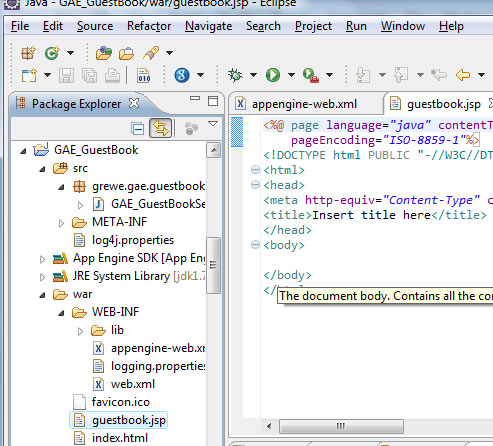|
CS6320: SW Engineering of Web Based Systems |
||||||
|
Google App Engine --- Java App --- Files and more
AppID and URL on GAE (not running locally)
Right click on Project ->Run->Run As-> GAE Server
Every app gets a free domain name on appspot.com, based on the application ID:
app-id.appspot.com
Requests for URLs that use your domain name are routed to your app by the frontend.
http://app-id.appspot.com/url/path...
Setup AppID --register in GAE dashboard and update appengine-web.xml file
STEP 1: Create App using GAE admin console "Create App" --- below I show you the details for an App that I created for testing. Note it has id = buzz-it adn its url is http://buzz-it.appspot.com

STEP 2: The app ID and version identifier of a Java app appear in the appengine-web.xml file.
The app ID is specified with the XML element <application>, and the version identifier
is specified with <version>. For example:
<?xml version="1.0" encoding="utf-8"?> <appengine-web-app xmlns="http://appengine.google.com/ns/1.0"> <application>ae-book</application> <version>dev</version> </appengine-web-app>
http://dev.latest.ae-book.appspot.com <<<< this is the dev version
another appengine-web.xml example:

NOTE: you can have up to 10 versions for an app (check current documentation for changes on this)
-
You can delete previous versions using the Administration Console.
Application IDs and version identifiers can contain numbers, lowercase letters, and
hyphens.
IMPORTANT: unlike normal webapps you will be using a web.xml file for Google App Engine

The web.xml file (Web App deployment -- standard Java WebApp prior to annotations like @WebServlet)
<?xml version="1.0" encoding="utf-8"?> <web-app xmlns:xsi="http://www.w3.org/2001/XMLSchema-instance" xmlns="http://java.sun.com/xml/ns/javaee" xmlns:web="http://java.sun.com/xml/ns/javaee/web-app_2_5.xsd" xsi:schemaLocation="http://java.sun.com/xml/ns/javaee http://java.sun.com/xml/ns/javaee/web-app_2_5.xsd" version="2.5"> <servlet> <servlet-name>GAE_GuestBook</servlet-name> <servlet-class>grewe.gae.guestbook.GAE_GuestBookServlet</servlet-class> </servlet> <servlet-mapping> <servlet-name>GAE_GuestBook</servlet-name> <url-pattern>/gae_guestbook</url-pattern> </servlet-mapping> <servlet> <servlet-name>GAE_GuestBookJSP</servlet-name> <jsp-file>guestbook.jsp</jsp-file> </servlet> <servlet-mapping> <servlet-name>GAE_GuestBookJSP</servlet-name> <url-pattern>/gae_guestbookJSP</url-pattern> </servlet-mapping> <welcome-file-list> <welcome-file>guestbook.jsp</welcome-file> </welcome-file-list> </web-app>In the above I mapped the jsp to the /gae_guestbookJSP url and also it is the welcome file
this means you can invoke it as http://localhost:8888/gae_guestbookJSP OR http://localhost:8888/guestbook.jsp
Result of the above running --note that the JPS file comes up as it is
the welcome file in the web.xml file
